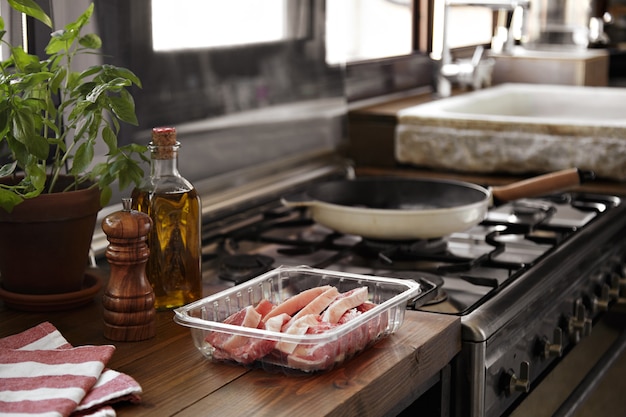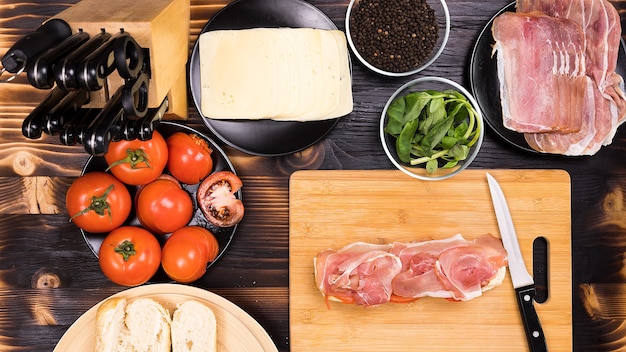Ah, the pre-cooked ham. A true lifesaver when you need a delicious meal in a hurry. But let's face it, reheating a ham can be a bit of a culinary gamble. Get it wrong, and you're left with a dry, rubbery disappointment. Get it right, and you have a succulent, juicy ham that's the star of the show.
I've been on both sides of the reheating spectrum. I've had hams so dry they could have been used as sandpaper. And I've had those moments of pure joy, when the ham came out perfectly moist and flavorful. Over the years, I've picked up some tricks that make all the difference. So, grab a cuppa, relax, and let's explore the art of reheating a ham, together.
(Part 1) The Great Reheating Debate: Oven vs. slow cooker

The first decision you need to make is: oven or slow cooker? Both methods have their pros and cons, and the best choice often depends on your ham's size and your personal preference.
Oven Reheating: Quick and Convenient
The oven is your go-to for a quick and easy reheat. It's simple, straightforward, and doesn't require any fancy equipment. You just pop the ham in the oven, let it bake for a bit, and voila! A warm, ready-to-eat ham. However, the oven can sometimes be a bit of a dry-heat culprit. If you're not careful, you might end up with a slightly rubbery ham.
Slow Cooker Reheating: The Ultimate Moisture Retention
The slow cooker, on the other hand, is the champion of moisture retention. It's like a cozy, warm hug for your ham, keeping it tender and juicy. This method is ideal for large hams, particularly those bone-in behemoths. Plus, you can add a touch of deliciousness by adding some liquid, like apple cider or broth, to the slow cooker.
The only downside to the slow cooker is that it takes a little longer than the oven. So, if you're on a tight schedule, the oven might be a better choice.
(Part 2) Choosing the Right Reheating Method: Factors to Consider

You've got your ham, your oven, and your slow cooker, but now it's time to make a decision. Here are some factors to consider when choosing the right reheating method:
- Size of the ham: Smaller hams are a perfect fit for the oven. Large, bone-in hams are best reheated in the slow cooker.
- Time constraints: If you need a quick reheat, the oven is your best friend. The slow cooker takes a bit more time.
- Desired outcome: For a moist, tender ham, the slow cooker is the winner. If you want a simple, quick reheat, the oven is a solid choice.
(Part 3) Oven Reheating: The Quick and Easy Way

Okay, let's dive into oven reheating. This method is perfect for smaller hams and those times when you need to reheat quickly. Here's the step-by-step process:
Steps for Oven Reheating:
- Preheat your oven: Set your oven to 325°F (160°C). This ensures even heat distribution.
- Prepare the ham: Place the ham in a roasting pan or baking dish. If it's wrapped in plastic, remove and discard the wrapping.
- Add some moisture: Pour a cup of water or apple cider into the bottom of the pan. This will help create steam and keep the ham moist.
- Cover the ham: Cover the ham tightly with foil. This creates a steamy environment and prevents the ham from drying out.
- Reheat the ham: Bake the ham for about 15-20 minutes per pound. This is a general guideline, so keep an eye on it.
- Check for doneness: Once the ham is heated through, remove it from the oven and let it rest for about 10 minutes before slicing. This allows the juices to redistribute.
These are general guidelines, and the actual reheating time will depend on the size of your ham. To be absolutely sure, use a meat thermometer to ensure the internal temperature reaches at least 140°F (60°C).
(Part 4) The Secret Sauce: Enhancing Flavor with Glaze and Glazing Tips
Now you've got a perfectly reheated ham, but it's just begging for that extra bit of flavor. Enter the glaze! A good glaze can transform your ham from ordinary to extraordinary.
Glaze Options:
- honey mustard glaze: A sweet and tangy glaze that always pleases the crowd.
- brown sugar glaze: A simple and classic glaze that's perfect for any ham.
- Apricot Glaze: A fruity and tangy glaze that's a guaranteed hit.
- maple glaze: A rich and decadent glaze that's perfect for a special occasion.
- pineapple glaze: A sweet and tangy glaze with a tropical twist.
Glazing Tips:
- Timing: Glaze your ham in the last 30 minutes of cooking. This allows the glaze to caramelize and create a beautiful, glossy finish.
- Brush it on: Use a pastry brush to spread the glaze evenly over the ham.
- Don’t overdo it: A thin layer of glaze is all you need. Too much glaze can make the ham sticky and soggy.
(Part 5) Slow Cooker Reheating: The Ultimate Moist and Flavorful Method
Now, let's talk about the slow cooker method. It's a more hands-off approach, but it results in a truly juicy, tender ham.
Steps for Slow Cooker Reheating:
- Prepare the ham: Place the ham in the slow cooker. Remove and discard any plastic wrapping.
- Add some liquid: Pour a cup of apple cider, broth, or even water into the bottom of the slow cooker.
- Cover and cook: Cover the slow cooker and cook on low heat for 2-3 hours, or until the ham is heated through.
- Add the glaze: In the last 30 minutes of cooking, brush the ham with your favorite glaze.
- Rest and serve: Once the ham is heated through, remove it from the slow cooker and let it rest for 10 minutes before slicing.
The slow cooker truly works its magic, infusing the ham with the flavors of the liquid and creating a super-moist, tender result. It's a great option for large hams that you want to keep warm for an extended period.
(Part 6) How to Tell When Your Ham is Done: Beyond Temperature
You've reheated your ham, but how do you know it's truly cooked through? Don't rely on time alone. Here are some ways to tell if your ham is ready to eat:
Visual Clues:
- Colour: The ham should be evenly cooked, with a golden brown color.
- Texture: The ham should be firm to the touch, not soft or mushy.
- Juices: If you insert a fork into the ham, the juices should run clear, not pink or bloody.
Temperature Check:
The most reliable way to determine if your ham is done is to use a meat thermometer. Insert the thermometer into the thickest part of the ham, making sure to avoid touching any bone. The internal temperature should reach at least 140°F (60°C).
(Part 7) Storage and Leftovers: Keeping the Ham Fresh and Delicious
You've reheated your ham, and it's absolutely delicious. But what about leftovers? Here's how to keep them fresh and tasty:
Storing Leftovers:
- Refrigerate promptly: Once the ham has cooled down to room temperature, refrigerate it in an airtight container. This prevents bacteria growth.
- Use within 3-4 days: leftover ham can be stored in the refrigerator for 3-4 days.
- Freeze for later: You can also freeze leftover ham for up to 2 months. Thaw it in the refrigerator before reheating.
Reheating Leftovers:
- Microwave: Reheat individual portions of ham in the microwave. Use a microwave-safe container and reheat on low power in short intervals.
- Oven: Reheat the ham in a preheated oven at 325°F (160°C) for about 15-20 minutes. Cover the ham with foil to prevent drying out.
- Slow Cooker: For a more hands-off approach, reheat the ham in the slow cooker on low heat for 2-3 hours. Add a little bit of liquid to the bottom of the slow cooker.
(Part 8) Ham Hacks: Creative Uses for Leftover Ham
Don't let those delicious leftovers go to waste! Here are some creative ways to use leftover ham:
ham and cheese quiche:
Dice up the leftover ham and add it to your favorite quiche recipe. The salty ham adds a delicious flavor to the quiche filling. It's a great way to use up leftover ham and make a satisfying meal.
Ham and potato soup:
A hearty and comforting soup that's perfect for a cold day. Simply add diced leftover ham to your favorite potato soup recipe. It adds a savory depth to the soup.
ham and cheese sandwiches:
A classic and satisfying lunch or snack. Use leftover ham to make delicious ham and cheese sandwiches. You can get creative with different cheeses and bread.
Ham and bean salad:
A refreshing and healthy salad that's perfect for a summer picnic. Combine leftover ham with black beans, corn, and your favorite salad dressing. It's a light and flavorful option.
Ham and broccoli stir-fry:
A quick and easy stir-fry that's packed with flavor. Combine leftover ham with broccoli, your favorite vegetables, and a stir-fry sauce. It's a healthy and satisfying meal.
(Part 9) FAQ: Your Reheating Questions Answered
Now that you've got all the tips and tricks, let's tackle some common reheating questions:
FAQs:
| Question | Answer |
|---|---|
| Can I reheat ham more than once? | It's best to reheat ham only once. Each reheating session decreases the moisture and quality of the ham. |
| Can I reheat a ham that's been frozen? | Yes, you can reheat a ham that's been frozen. Just make sure to thaw it completely in the refrigerator before reheating. |
| What happens if I overcook my ham? | Overcooked ham will be dry and tough. It's best to err on the side of caution and undercook it slightly. You can always reheat it for a few more minutes if needed. |
| Can I reheat ham in the microwave? | You can, but it’s not the best method. Microwaving ham can make it dry and rubbery. If you must reheat in the microwave, do so on low power and in short intervals. |
| How do I know if my ham is spoiled? | If your ham has a bad smell, a slimy texture, or has changed colour significantly, it's likely spoiled and should be discarded. |
There you have it. Now you're equipped with the knowledge to reheat a ham like a pro, creating a moist, juicy, and flavorful feast for yourself and your loved ones. Go forth and reheat with confidence!
Everyone is watching

How to Cook Frozen Lobster Tails Perfectly: A Step-by-Step Guide
RecipesLobster. Just the word conjures up images of lavish meals, special occasions, and a taste of luxury. But let's...

Pigs in a Blanket Cooking Time: How Long to Bake for Perfect Results
RecipesAh, pigs in a blanket. Just the name conjures up images of those delightful little parcels of crispy pastry en...

Pork Fillet Cooking Time: How Long to Cook It Perfectly
RecipesPork fillet, or tenderloin as it's sometimes called, is a real favourite in our house. It's so versatile, and...

The Ultimate Guide to Cooking Delicious Frankfurters
RecipesLet's face it, we all love a good frankfurter. It's a classic, simple, and always satisfying. But let's be rea...

The Ultimate Guide to Tender, Juicy Pulled Pork
RecipesRight, let's talk pulled pork. It's one of those dishes that just screams "comfort food," doesn't it? I mean...
